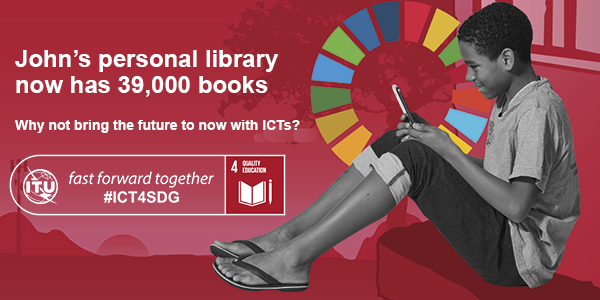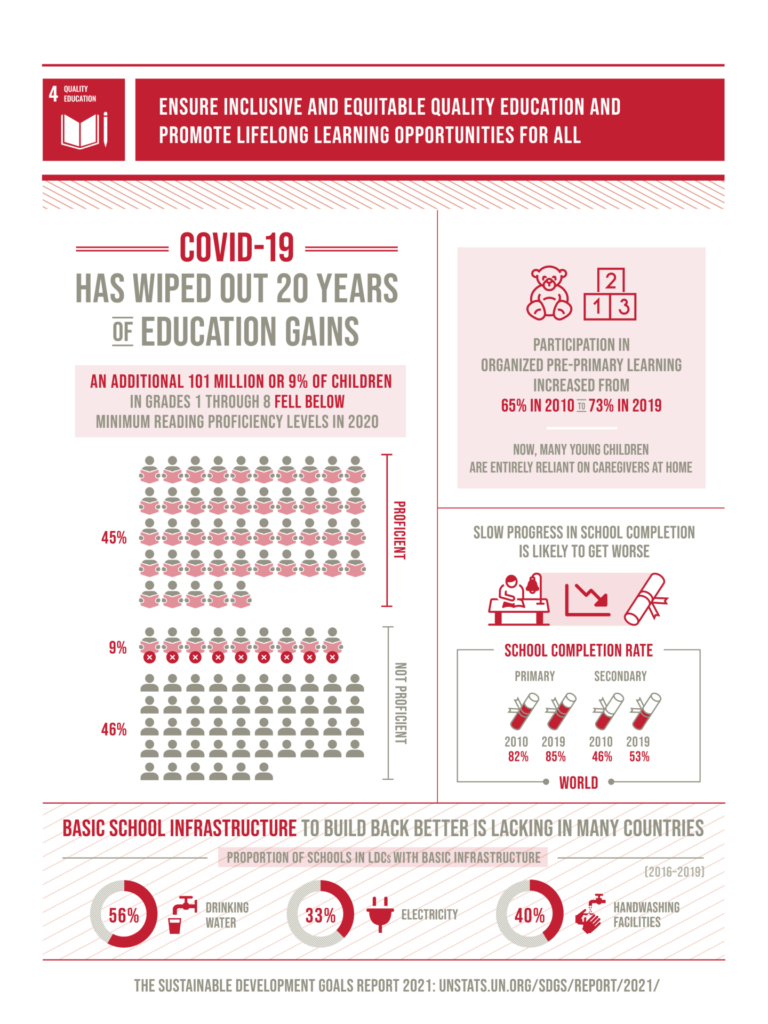

Education is a human right with immense power to transform.
Kofi Annan, Former United Nations Secretary-General
On its foundation rest the cornerstones of freedom, democracy and sustainable human development.
Information and communications technology (ICT) is powering a revolution in digital learning, which has become one of the world’s fastest-growing industries. Mobile devices now allow students to access learning assets anytime, anywhere. Teachers now use mobile devices for everything from literacy and numerical training to interactive tutoring. Indeed, mobile learning can help break down economic barriers, divides between rural and urban areas, and gender divides.
#ICT4SDG
International Telecommunication Union (ITU)
Digital technology is critical to accelerate the attainment of the SDG by 2030 and ensure that no one is left behind. Although ICT has been recognized as a strategic, sector cross-cutting enabler for development, many people worldwide are still not benefitting from its transformative power. Despite significant efforts towards ICT-enabled solutions for development, stakeholders often operate and develop solutions in a ‘siloed’ manner, which leads to significant duplication and fragmentation of efforts and affects resource effectiveness. Maximizing digital technology’s leverage on global development requires new ways of cooperation and pooling of efforts and resources among various stakeholders.
The “Mainstreaming ICT for SDG” project is a collaboration between the International Telecommunication Union (ITU) and the Digital Impact Alliance (DIAL), which aims to address existing challenges in achieving SDG targets by providing the guidance needed to decision-makers and donors investing in ICT. The project proposed solutions for donors and other stakeholders, including states and tech entrepreneurs , to maximize their return on investments (RoI) and accelerate progress towards the SDG by adopting a whole-of-government approach.
A whole-of-government approach to ICT investment is required to deliver impact at scale, and the SDG provides a strong strategic foundation for digital transformation that is integrated across government horizontally and vertically. First, the interrelatedness of the SDGs provides an opportunity for common approaches and integration within and across institutions, creating an environment primed for systems-level, rather than project-level, thinking. Second, limited resources require a whole-of-government architectural approach that takes advantage of economies of scale that are not available to ICT and implements them piecemeal. The high cost of institutionalizing ICT solutions dictates that, as much as possible, the number of ICT solutions needing to scale must be minimized. Third, integration is necessary for government programming to deliver end-to-end value to consumers at scale reliably.
An SDG Digital Investment Framework was developed as an analytical guide to digital investment by identifying reusable ICT building blocks** to deliver priority SDG use cases. At the heart of the methodology is the notion that many recurring themes exist across the SDG targets. These themes also appear in the use cases where governments prioritize delivering to achieve those targets. These use cases can be broken down into standard functionality implemented in multiple sectors (via workflows), with each workflow reusing the same underlying software components (ICT building blocks).
** Reusable ICT Building Blocks are technology components that provide an underlying, fundamental function in multiple software applications and systems. They are designed to be shared and repurposed for different use cases. Examples include specific database structures and information architectures, e-commerce platforms, messaging services, geographic information services (GIS), or digital identity management.
Updated December 4. 2024 & December 4. 2023 (originally posted December 5. 2021)

United Nations Global Goals for Sustainable Development
Education enables upward socioeconomic mobility and is a key to escaping poverty.
Progress towards quality education was already slower than required before the pandemic, but COVID-19 has had devastating impacts on education, causing learning losses in four out of five of the 104 countries studied. Without additional measures, an estimated 84 million children and young people will stay out of school by 2030 and approximately 300 million students will lack the basic numeracy and literacy skills necessary for success in life.
In addition to free primary and secondary schooling for all boys and girls by 2030, the aim is to provide equal access to affordable vocational training, eliminate gender and wealth disparities, and achieve universal access to quality higher education. Education is the key to achieving many other Sustainable Development Goals (SDGs). When people are able to get quality education, they can break the cycle of poverty.
Education helps reduce inequalities and achieve gender equality. It also empowers people everywhere to live more healthy and sustainable lives. Education is crucial to fostering tolerance and contributing to more peaceful societies.
To deliver on Goal 4, education financing must become a national investment priority. Furthermore, measures such as making education free and compulsory, increasing the number of teachers, improving basic school infrastructure, and embracing digital transformation are essential.
What progress have we made so far?
While progress has been made towards the 2030 education targets set by the United Nations, continued efforts are required to address persistent challenges and ensure that quality education is accessible to all, leaving no one behind. Between 2015 and 2021, there was an increase in worldwide primary school completion, lower secondary completion, and upper secondary completion. Nevertheless, the progress made during this period was notably slower compared to the 15 years prior.
About 260 million children were still out of school in 2018—nearly one-fifth of the global population in that age group. More than half of all children and adolescents worldwide are not meeting minimum proficiency standards in reading and mathematics.
In 2020, as the COVID-19 pandemic spread across the globe, most countries announced the temporary closure of schools, impacting more than 91 percent of students worldwide. By April 2020, close to 1.6 billion children and youth were out of school, and nearly 369 million children who rely on school meals needed to look to other sources for daily nutrition.
Never before have so many children been out of school at the same time, disrupting learning and upending lives, especially the most vulnerable and marginalized. The global pandemic has far-reaching consequences that may jeopardize hard-won gains in improving global education.
COVID-19 response
To foster international collaboration and ensure that education never stops, UNESCO is mounting a response with initiatives that include the global monitoring of national and localized school closures.
To protect the well-being of children and ensure they have access to continued learning, UNESCO in March 2020 launched the COVID-19 Global Education Coalition, a multi-sector partnership between the UN family, civil society organizations, media, and IT partners to design and deploy innovative solutions. Together, they help countries tackle content and connectivity gaps and facilitate inclusive learning opportunities for children and youth during this sudden and unprecedented educational disruption.
Specifically, the Global Education Coalition aims to:
- Help countries in mobilizing resources and implementing innovative and context-appropriate solutions to provide education remotely, leveraging hi-tech, low-tech and no-tech approaches;
- Seek equitable solutions and universal access;
- Ensure coordinated responses and avoid overlapping efforts;
- Facilitate the return of students to school when they reopen to prevent an upsurge in dropout rates.
UNICEF also scaled up its work in 145 low- and middle-income countries to support governments and education partners in developing plans for a rapid, system-wide response, including alternative learning programs and mental health support.
Facts and Figures
- Before the coronavirus crisis, projections showed that more than 200 million children would be out of school and that only 60 percent of young people would complete upper secondary education in 2030.
- Before the coronavirus crisis, the proportion of children and youth out of primary and secondary school had declined from 26 percent in 2000 to 19 percent in 2010 and 17 percent in 2018.
- More than half of children who have not enrolled in school live in sub-Saharan Africa, and more than 85 percent of children in sub-Saharan Africa are not learning the minimum
- 617 million youth worldwide lack basic mathematics and literacy skills.
- Some 750 million adults – two-thirds women – remained illiterate in 2016. Half of the global illiterate population lives in South Asia, and a quarter live in sub-Saharan Africa.
- In 10 low- and middle-income countries, children with disabilities were 19 percent less likely to achieve minimum proficiency in reading than those without disabilities.
- 4 million refugee children were out of school in 2017
Goal 4 Targets
4.1 By 2030, ensure that all girls and boys complete free, equitable, and quality primary and secondary education leading to relevant and Goal-4 effective learning outcomes
4.2 By 2030, ensure that all girls and boys have access to quality early childhood development, care, and preprimary education so that they are ready for primary education
4.3 By 2030, ensure equal access for all women and men to affordable and quality technical, vocational, and tertiary education, including university
4.4 By 2030, substantially increase the number of youth and adults who have relevant skills, including technical and vocational skills, for employment, decent jobs, and entrepreneurship
4.5 By 2030, eliminate gender disparities in education and ensure equal access to all levels of education and vocational training for the vulnerable, including persons with disabilities, Indigenous peoples, and children in vulnerable situations
4.6 By 2030, ensure that all youth and a substantial proportion of adults, both men and women, achieve literacy and numeracy
4.7 By 2030, ensure that all learners acquire the knowledge and skills needed to promote sustainable development, including, among others, through education for sustainable development and sustainable lifestyles, human rights, gender equality, promotion of a culture of peace and non-violence, global citizenship and appreciation of cultural diversity and culture’s contribution to sustainable development
4.A Build and upgrade education facilities that are child, disability, and gender-sensitive and provide safe, nonviolent, inclusive, and effective learning environments for all
4.B By 2020, substantially expand globally the number of scholarships available to developing countries, in particular, least developed countries, small island developing States, and African countries, for enrolment in higher education, including vocational training and information and communications technology, technical, engineering and scientific programs, in developed countries and other developing countries
4.C By 2030, substantially increase the supply of qualified teachers, including through international cooperation for teacher training in developing countries, incredibly least developed countries, and small island developing states
Links
UN Educational, Scientific and Cultural Organization
Global Education First Initiative
UN Population Fund: Comprehensive sexuality education
UN Office of the Secretary General’s Envoy on Youth






15 Comments
Pingback: kel tec ksg
Pingback: วิเคราะห์บอล
Pingback: Angthong National Marine Park
Pingback: Dan Helmer
Pingback: trustbet
Pingback: เรียนต่อออสเตรเลีย
Pingback: Event venue phuket
Pingback: โรงงานผลิตสายรัดพลาสติก
Pingback: JZ-500
Pingback: เช่ารถตู้พร้อมคนขับ
Pingback: my site
Pingback: hr42
Pingback: Ricky Casino
Pingback: ซอฟต์แวร์การจัดการโครงการ
Pingback: mostbet aviator